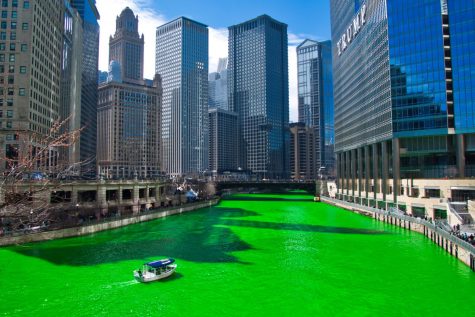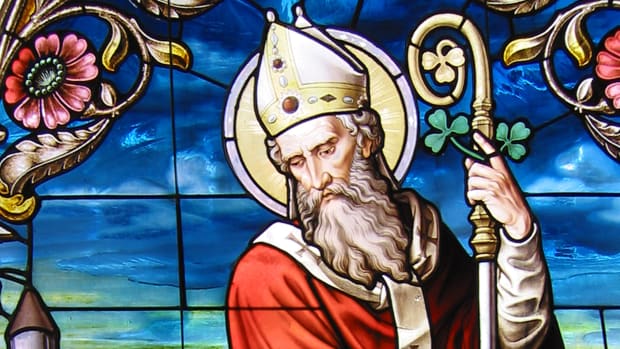The History and Festivities of St. Patrick’s Day
Many vibrant St. Patrick’s Day traditions got their start hundreds of years ago.
A stained-glass window with portrait of St. Patrick.
Every March 17th, St. Patrick’s Day celebrations incorporate parades, leprechauns, shamrocks, and pretty much anything green. Each component of this holiday has a backstory that has helped make it one of the most popular days of the year.
The man behind this triumphal day is St. Patrick of Roman Britain. His story begins frightfully when he is taken hostage and brought to Ireland to perform as a slave. He was able to escape his hostages and return to his homeland. However, in a shocking turn of events, he returned to Ireland, bringing back with him teachings that would forever remain in the Irish culture. The Irish no longer viewed him as not a slave, but as a man with great religious ideas.
He explained the religion of Christianity, and the Irish were greatly accepting of the Holy Trinity, which defines the Father, the Son, and the Holy Spirit. St. Patrick elaborated on these three points with a native Irish clover consisting of three green leaves. This is how the shamrock became a very common symbol that represents St. Patrick’s Day.
Another symbolic figure of this holiday are leprechauns. Believe it or not, leprechauns have nothing to do with St. Patrick. They are only what the Irish believe to be as male and female fairies who use magical powers for good or evil. Fairies were celebrated on March 13th, and since the dates were so close, they are now celebrated with St. Patrick’s Day. Nonetheless, the legend of St. Patrick never mentions anything of these mythical creatures.
St. Patrick died on March 17th in the year 461 AD in Saul where he had built his first church. Evidently, instead of March 17th being viewed as a day a history-altering man died, it is a triumphant day when people celebrate him as someone who taught many a belief that much of the world still values.
Hundreds of years later, historians studied the events of St. Patrick and soon realized that this was no story that was to be ignored and that it was to be commemorated annually. This is how the infamous holiday extravaganza began around the ninth or tenth century.
Shockingly enough, these particular jubilant parades did not take place where the story occurred in Ireland. They began right here in America, specifically St. Augustine Florida, which was a Spanish colony at the time of the first celebration in 1601.
As Catholic Irish immigrants gradually entered the United States, the holiday became even more popular, resulting in enlargements of parades and parties. However, many non-Irish Americans were not willing to embrace the celebrations at the time.
Instead, the participants were looked at as disruptions, nuisances, and even public-drunks. Eventually, the American Irish population increased to the point where they were able to assume more political power.
This power allowed them to take part in organizations that put even more celebrations on the streets of America. By the 20th century, nearly every city in the United States of America had booming, entertaining, and religious parades to celebrate St. Patrick’s Day.
A proud day of Irish history is when Democratic President Harry S. Truman attended a St. Patrick’s Day parade in New York City in 1948. It meant that the the work of many people who identified themselves of having Irish heritage had finally paid off, even after many racist and discriminatory acts were brought forth against them. They were thankful that those sorrowful events against their heritage were no more.
Many of these commemorations take place on city streets, but Chicago takes it even further than that. It dyes its own river and turns the water green. Each year, boaters take multiple pounds of green vegetable dye and pour into the Chicago River.

This idea was a result of what began as an investigation conducted by Chicago’s pollution-control team. In 1962, they dumped the vegetable dye in order to discover any illegal sewage discharge. They soon realized that this could be a celebratory tradition like no other. That year, 100 pounds of green vegetable dye spilled into a portion of the Chicago River and turned the color of the water for an entire week.
In following years, in order to minimize the environmental damage that this may cause, city decreased the amount of dye to 40 pounds, enough to change the water color for several hours.
Chicago historians claim this idea to be original. Some historians, on the other hand, say they had it first.
People of Savannah, Georgia claim this distinctive idea came from a Savannah citizen who thought it would be creative to turn their river green in honor of St. Patrick. However, unlike Chicago’s plan, they’re idea backfired and only turned a portion of their river a shade of blue, not green.
Unlike Chicago or Savannah, city officials of Pittsburgh keep their St. Patrick’s Day celebrations casual. The parades routinely move throughout the downtown area, usually on Liberty Avenue, Boulevard of The Allies, or Stanwix Streets.
As many remember, the 2020 parades honoring St. Patrick was cancelled due to the COVID-19 pandemic. As of now, the 2021 Pittsburgh celebrations have only been postponed.
Therefore, a glimmer of hope lies within the minds of many who enjoy celebrating a day that has been a wonderful part of not only the Irish heritage, but also to the world at large.

Anthony Durzo is a senior at North Allegheny Senior High School. This is his second year writing for The Uproar, although he has previously written for North Allegheny Intermediate's online newspaper, NAEye, for two years as well. Outside of school, he played hockey at Robert Morris University for eight years and has played piano for six. After tossing his cap into the air and waving goodbye to North...


